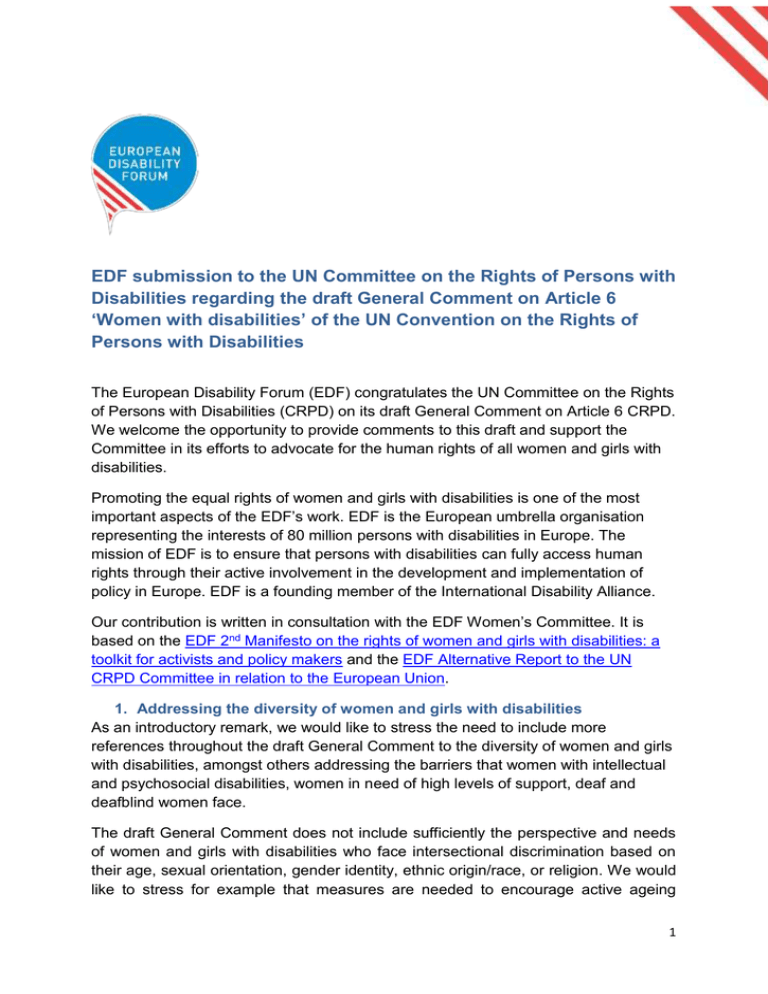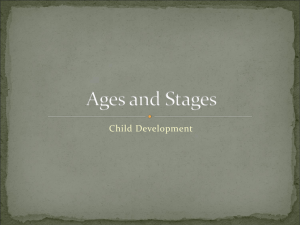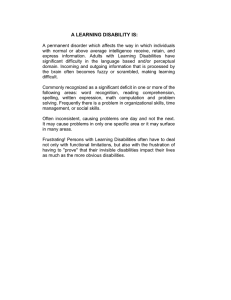
EDF submission to the UN Committee on the Rights of Persons with
Disabilities regarding the draft General Comment on Article 6
‘Women with disabilities’ of the UN Convention on the Rights of
Persons with Disabilities
The European Disability Forum (EDF) congratulates the UN Committee on the Rights
of Persons with Disabilities (CRPD) on its draft General Comment on Article 6 CRPD.
We welcome the opportunity to provide comments to this draft and support the
Committee in its efforts to advocate for the human rights of all women and girls with
disabilities.
Promoting the equal rights of women and girls with disabilities is one of the most
important aspects of the EDF’s work. EDF is the European umbrella organisation
representing the interests of 80 million persons with disabilities in Europe. The
mission of EDF is to ensure that persons with disabilities can fully access human
rights through their active involvement in the development and implementation of
policy in Europe. EDF is a founding member of the International Disability Alliance.
Our contribution is written in consultation with the EDF Women’s Committee. It is
based on the EDF 2nd Manifesto on the rights of women and girls with disabilities: a
toolkit for activists and policy makers and the EDF Alternative Report to the UN
CRPD Committee in relation to the European Union.
1. Addressing the diversity of women and girls with disabilities
As an introductory remark, we would like to stress the need to include more
references throughout the draft General Comment to the diversity of women and girls
with disabilities, amongst others addressing the barriers that women with intellectual
and psychosocial disabilities, women in need of high levels of support, deaf and
deafblind women face.
The draft General Comment does not include sufficiently the perspective and needs
of women and girls with disabilities who face intersectional discrimination based on
their age, sexual orientation, gender identity, ethnic origin/race, or religion. We would
like to stress for example that measures are needed to encourage active ageing
1
among women with disabilities and reduce the high illiteracy rates among older
women with disabilities, as well as to increase the use of new information and
communication technologies by this group or women in lifelong learning programmes.
We made some recommendations on LGBTI women with disabilities below under
Article 23 CRPD.
2. Inequalities between women and men with disabilities (paragraphs 2 and
62)
EDF welcomes the reference made in paragraph 2 that ‘policies addressed by
women have made disability invisible and policies on disability have forgotten gender,
perpetuating the situation of multiple discrimination’. We would like to add that ‘the
status of women with disabilities is not only worse than that of women without
disabilities, but also worse than that of their male peers. This is especially so in rural
areas with fewer services and opportunities for this group than in urban
environments’.
EDF welcomes the reference to the two track approach to gender and disability in
paragraph 14, and the important call for State Parties in paragraph 62 ‘to install
gender and disability mainstreaming and – budgeting in all policies and programmes’.
It is important to add here that ‘these policies and programmes should address the
inequality between women and men with disabilities’.
3. Recognition of multiple and intersectional discrimination (paragraph 17)
EDF confirms that at the EU level and in many EU Member States, antidiscrimination legislation also fails to address multiple and intersectional
discrimination as mentioned in paragraph 9. We welcome the recognition in
paragraph 17 that ‘multiple discrimination often has aggravating or compounding
effects’ and ‘merits particular consideration and remedying’. We would like to add
here that ‘State Parties should put in place strong mechanisms for sanctions and
remedies to punish non-compliance with higher penalties and injunctive reliefs1 in
cases of multiple and intersectional discrimination’.
4. Involvement at regional and national level of women and girls with
disabilities and their representative organisations (paragraph 67)
Paragraph 67 mentions that State Parties have the obligation to ‘engage with women
and girls with disabilities through their representative organisations, in drawing up
and implementing legislation and policies […]’. We would like to add here that
‘women and girls with disabilities, through their representative organisations need to
play an active role in the monitoring bodies at national and regional level that are
established under article 33, 2 CRPD’.
Paragraph 67 states that ‘networks and organisations of women and girls with
disabilities need to be adequately facilitated’. We would like to add here that
‘mechanisms and structures allowing the voices of women with disabilities to be
heard and enabling them to engage politically as actors in both organizations of
2
persons with disabilities and women’s organizations must be established. European
and national bodies engaged in women’s advancement must include participation by
women with disabilities’.
5. Violence against women and girls with disabilities (paragraph 6)
We would like to inform the Committee of an 2014 EU-wide survey on violence
against women. This survey shows that women with disabilities experience more
violence than women without disabilities in Europe and that this violence is mainly
interpersonal. 34% of women with disabilities face physical and sexual partner
violence, compared to 19% of women without disabilities. Also psychological violence
and threats of violence by a partner, violence in childhood and non-partner violence
are more common among women with disabilities.2
We would like to see more guidance of the Committee in the General Comment on
measures of prevention, care and recovery of victims. The State Parties should take
measures of appropriate support, accessible information and protection against
abuse for all women with disabilities, in particular those in the most vulnerable
situations. An adequate legal framework and research should be established by
State Parties in relation to violence against women and girls with disabilities.
6. Sexual and reproductive rights (paragraph 7 and 37)
We want to underline here the importance of the right to sexual and reproductive
freedom for all women and girls with disabilities, as mentioned in paragraph 7. Many
women with disabilities are still denied the right to sexual and reproductive freedom
under the pretext of their wellbeing. Many women with disabilities are denied a sexual
life as they are considered asexual. Forced sterilization, female genital mutilation and
coerced abortion are just some clear examples of denial of rights that many women
and adolescents with disabilities suffer, without giving their consent or fully
understanding the intentions.
We would like to add to paragraph 7 that ‘women with disabilities should have the
right to give informed consent or understanding to all medical procedures including
sterilisation and abortion, and receive support in making these decisions. Legal
safeguards should exist for those women who are incapable of giving their informed
consent on questions related to reproduction. In particular, contraception should
never be prescribed nor termination of pregnancy carried out against the will of a
woman with disabilities’.
We would like to add to paragraph 37 ‘the need for awareness-raising and accessible
information campaigns on the right to sexual and reproductive freedom and against
forced sterilization, female genital mutilation and coerced abortion. These campaigns
should target girls and women with disabilities and their families, and professionals in
justice, education, health and social services’.
3
7. Training programmes (paragraph 37)
Paragraph 37 should include the need for ‘appropriate information and training
programs for women and girls with disabilities and mothers of boys or girls with
disabilities about their rights and fundamental freedoms, and the opportunities they
have to access justice, with a particular focus on those groups at greater risk of
discrimination, such as women with high support needs, women with disabilities in
institutions, older women, women with disabilities who live in rural settings or who are
discriminated based on their age, ethnic origin, sexual orientation or religion’.
8. The right to live in the community for girls with disabilities (paragraph
47)
The draft General Comment should underline the need to adopt measures for girls
with disabilities to prevent their institutionalisation. We would like to add in paragraph
47 that ‘in order to prevent concealment, abandonment, neglect and segregation of
girls with disabilities, information campaigns should be promoted aimed at their
families and providing information on community resources which are available for
their future care and development. Such campaigns should contribute to breaking
down sexist and discriminatory stereotypes. If the immediate family is unable to care
for a girl with disabilities, public authorities must provide alternative care within the
extended family and, if this is not feasible, within the community in a family setting.
Fostering and adoption of girls with disabilities should be encouraged, including
simplified bureaucratic processes and offering suitable information to foster and
adopting families regarding the human rights of all persons with disabilities.’
9. Access to justice (paragraph 44)
We welcome the reference in paragraph 44 that ‘women and girls with disabilities’
effective access to accessible, easy-to-use and safe justice must be ensured’. We
would like to highlight that the rights of women and girls with disabilities to effective
access to justice is still widely violated as a result of invisibility, mistaken beliefs and
a lack of recognition in society in general for their human rights and fundamental
freedoms. Women with disabilities are often not taken as credible during legal
proceedings. When reporting rape to a policy officer, they are often not believed for
example.
We would like to add to paragraph 44 that ‘suitable gender- and disability-awareness
training should be promoted, not only for women and girls with disabilities, but also
for all those working in the field of administration of justice, including police and
prison staff. These trainings are especially needed in matters related to divorce,
separations and child custody, and including cases involving mothers of boys or girls
with disabilities. Substantive criminal law and criminal procedures shall be reviewed
to identify violent situations involving women whose disability is a relevant factor in
the criminal act, in order to enable tougher sentences to be passed to punish such
behaviour due to the greater vulnerability of the victims’.
4
10. Employment (paragraph 52)
We welcome the references made in paragraphs 51-57 on the importance of
obtaining and maintaining an employment as one of the most effective tool for the
inclusion of women with disabilities. We would like to add that not only women with
disabilities are discriminated on grounds of disability in employment, but also mothers
with girls or boys with disabilities. Mothers of girls or boys with disabilities have
problems to find, maintain and return to employment because they are seen as less
engaged workers because of their child’s disability. Mothers of girls and boys with
disabilities should also be beneficiaries of the support and protection mentioned in
paragraph 52.
11. Additional CRPD articles to include
We would recommend to the UN Committee to add guidance on important articles for
women and girls with disabilities: articles 14, 15, 23, 25, 26, 28, 29 and 30 CRPD.
Under Article 23, respect for home and the family we would like to include that ‘all
women with disabilities, including lesbians, bisexual and transsexual women with
disabilities have the right to enter into relationships which involve living a stable life
with a partner and should enjoy the protection of public authorities, such as, among
others, civil unions or civil partnerships. It is necessary to change discriminatory
attitudes and legislation towards women with disabilities with regard to maternity,
especially in terms of the right to assisted reproduction, becoming the legal custodian
in the event of divorce, adoption, foster-parenthood, other forms of social parenthood
and the use of artificial insemination. Necessary measures should be taken in terms
of awareness, information and training aimed at both the families of girls and women
with disabilities and professionals.’
In its guidance under Article 26 CRPD, the General Comment should highlight the
right of women and girls with disabilities to have free access to habilitation and
rehabilitation services as well as assistive devices and aids. Public authorities and
social services should consider poverty as a priority factor when allocating resources.
Bearing in mind the higher levels of poverty experienced by this group, women and
girls with disabilities must have access to free, or at least affordable, assistive
devices and aids which are suitably designed for them.
Contact details
An-Sofie Leenknecht, Human Rights Officer, European Disability Forum,
Ansofie.Leenknecht@edf-feph.org, 00322824602.
1
An injunctive relief is a judicial remedy in the form of a court order that requires a party to do or
refrain from doing specific acts. A party that fails to comply with an injunction can face criminal or civil
penalties, including possible monetary sanctions. National discrimination law, as for example in Austria
often foresees only financial compensation although other kinds of sanctions, such as injunctive reliefs
in case of inaccessibility for example would be much more sustainable and effective.
2 See Fundamental Rights Agency, an EU-wide survey: violence against women, 2014, p. 186-187
(available at http://fra.europa.eu/en/publication/2014/vaw-survey-main-results)
5



